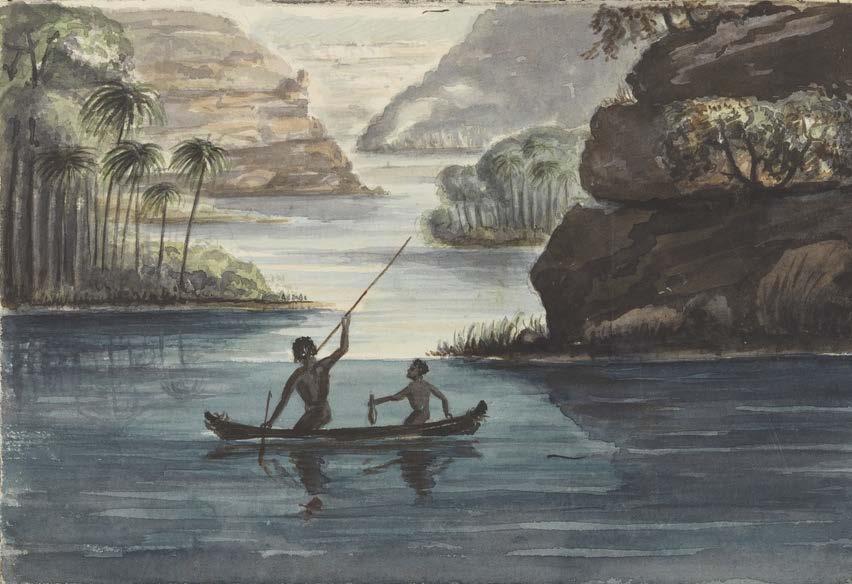
4 minute read
Aboriginal Heritage
Mosman has a rich Aboriginal heritage with over 100 recorded sites. The land was long occupied by First Nations people, with evidence of their life in the Sydney region dating as far back as 15,000 to 40,000 years ago. The footprint of their lives, culture, and beliefs is still evident in local rock art and middens. Aboriginal heritage is important to us all. Through this heritage, we can begin to understand how the original custodians lived in harmony with nature and their environment. We can learn important lessons about sustainability and conservation. As a community, we can develop our appreciation and respect for Aboriginal culture and heritage and how this informs our future.
Pre 1788
Before European arrival in 1788, Indigenous culture in coastal Sydney was rich and complex with many languages and customs and strong links to the land. Sadly, with the European arrival, loss of traditional hunting lands, and introduction of new diseases, the local Aboriginal population was decimated. The heritage sites provide a valuable legacy and we must all take responsibility to protect them.
People
People belonged to small groups or clans which connected them spiritually to the land and each other. From the available information, it is understood there were two main clans in Mosman numbering a few thousand at the time of European arrival. They hugged the coastline and as coastal groups, were mainly fishers, hunters and gatherers: the Cammeraygal (or Cammeraigal) who lived on the north shore of Port
Jackson known as the country of
Cammeray and bay of Cameera; the Borogegal who lived east of the
Cammeraygal but also on the north shore of Port Jackson and the western side of Middle Harbour, and were particularly associated with Booragy/
Burogy (now known as Bradleys Head).
The Indigenous people camped in areas that provided shelter and with good food and water supplies. The shelters included rock overhangs, or were constructed from bark, branches, and leaves. The people ate well with a rich diet of fish, crabs and crayfish, shellfish, seal, dugong, eels, kangaroo, wallaby, possum, snakes, lizards, birds, bird eggs, native edible fruit, seeds, berries, roots and native honey. They used a variety of tools with fishing undertaken with spears, shell hooks and lines and fish traps. Hunters used spears, clubs, traps and snares. Food was cultivated and gathered using wooden digging sticks and carried in net bags or bark baskets.
Bungaree
With the European arrival, the landscape changed quickly with parts of Mosman used for whaling and farming. In 1815, a farm was established on the orders of Governor Macquarie at Middle Head for Indigenous families with an Aboriginal man named Bungaree. As well as being famous for circumnavigating Australia with Matthew Flinders, Bungaree also acted as an effective intermediary. The aim of the farm was to ‘acculturate’ a group of 16 Indigenous families to European life and farming. Although Bungaree remained for a short time, most of the families quickly abandoned the farm.
Sites
Local indigenous sites encompass rock art, middens and burials. Middens are collections of discarded materials building up to a form of deposit that survives to this day. Shell, animal bone, ochre, stone artefacts, charcoal and
ABORIGINAL HERITAGE
even human remains may be present in middens. Most in coastal Sydney are shell middens close to the foreshore. Rock art includes engravings and pigment art and is mostly of animal or human figures. Engravings are some form of image that has been carved or pecked into a rock surface. The Hawkesbury sandstone in the region provides an excellent surface for engravings. Twothirds of the engravings in Mosman are of marine animals. Pigment art is the application of a material such as ochre, charcoal or pipeclay to rock or stone. It is often found in shelter sites. In Mosman, most pigment art is of hand stencils with others of kangaroos and wallabies. Burials are locations where human skeletal remains are present and occurred on land given special status. There are three recorded burial sites in Mosman.
Protection
The natural deterioration of archeological sites may take thousands of years but deliberate or accidental human acts can speed this up and result in loss of these sites for future generations. Indigenous heritage sites should not be walked on or tampered with, including middens and rock art. All Aboriginal sites are protected under Commonwealth and State laws and it is illegal to destroy, damage, or remove Aboriginal heritage items. Council, the National Parks and Wildlife Service, Sydney Harbour Federation Trust and Northern Sydney Reconciliation Network work collaboratively with the Metropolitan Local Aboriginal Land Council to protect and promote Aboriginal culture and heritage. Residents can also enjoy learning and sharing contemporary Aboriginal culture through the collections and exhibitions of Mosman Art Gallery and the local and regional events held during the Gaimariagal Festival between May and July each year. To find out more about Mosman’s Aboriginal heritage, visit Barry O’Keefe Library or Council’s website for Aboriginal Heritage of Mosman (NPWS 2010), which Council acknowledges as the source of this summarised information.













